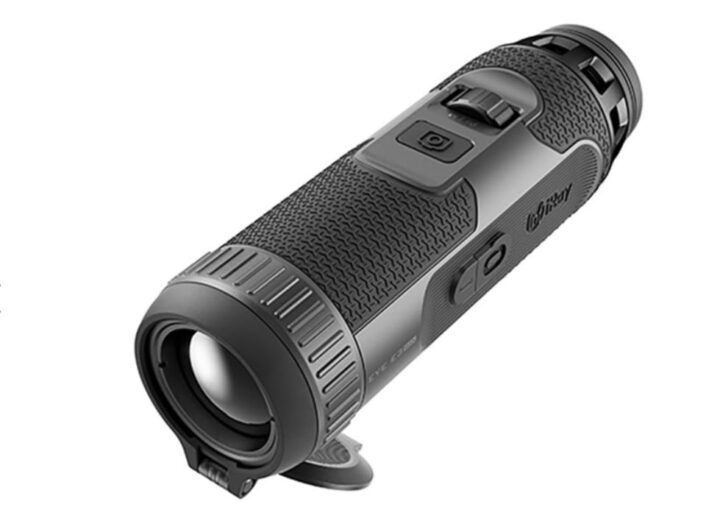Best Thermal Monocular Under $1000
If you choose the highest-end models in terms of functionality, a thermal monocular can get quite pricey. Because of this, manufacturers have created inexpensive choices that, despite being limited in some ways, still deliver outstanding performance at a reasonable price.
This article aims to review the best thermal monocular, in terms of performance and dependability, with a focus on models priced under $1,000.
Let’s begin…
Thermal Monocular Under $1000-Top Picks
| Product | Image | How To Buy |
| ATN OTS-XLT 2.5-10x
|
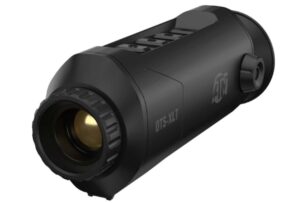 |
|
| Kinsei Thermal Monocular | 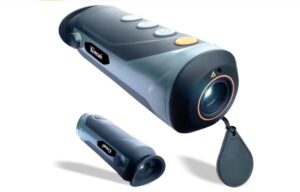 |
|
| Burris BTH 35 2.3-9.2x35mm | 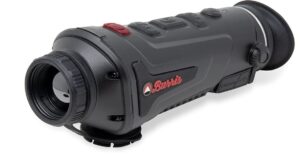 |
|
| FLIR Systems Ocean Scout TK | 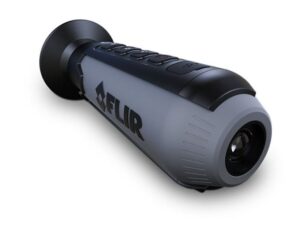 |
|
| AGM Taipan TM10-256 | 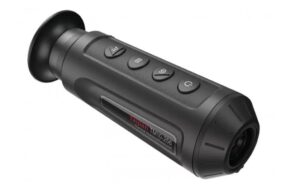 |
|
| FLIR Systems Scout TK Mini | 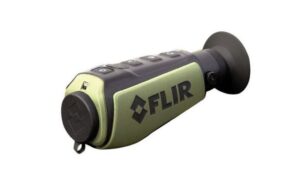 |
Here are the detailed reviews….
1. ATN OTS-XLT 2.5-10x Thermal Viewer

The ATN OTS-XLT carries on the reputation of the ATN brand when it comes to optics. It gives the user a noteworthy performance at the same time protecting his wallet. It’s so good you’ll hardly notice that it’s among the cheaper options available from ATN.
Firstly, this thermal monocular uses a very small sensor with just 160 x 120 pixels of resolution, and it’s difficult to understand how it pulls off and delivers decent sensitivity, with an identification range of 210 meters.
In addition, it is available with a rangefinder that gives the user an accurate distance to the target up to a distance of 263 yards.
It’s lightweight, weighing just 0.81 lbs., easy to use, and gives a good battery life of 10 hours when used continuously.
Features
- Sensor Resolution: 160×120 pixels
- Magnification: 2.5 – 10 x
- Field of View, Angle: 4.9 – 6.9 degrees
- Battery Life: 10 hours
- Dimensions: 6.85 x 2.63 x 2.08 in
- 50 Hz refresh rate
- Water Resistance Level: IP67
- 3 color palettes- White Hot / Black Hot / Red Hot /
- Image capture and video recording abilities
- 8GB internal storage to save recordings
- Weight: 370 g
2. Kinsei Thermal Imaging Monocular

This is a relatively unknown monocular, but those who have used it can attest to its high quality. It’s almost a closely guarded secret.
The Kinsei thermal monocular is a Chinese device that may raise your skepticism at first, especially given its low price of just over $500 and the features it provides. These features would command a much higher price for a monocular from another brand.
The image clarity is the first thing that stands out. It employs a thermal sensor with a resolution of 256×192 pixels that can detect vehicles and animals at distances of 455 and 155 yards, respectively.
The user’s display is an LCOS with a resolution of 720×540 pixels, which produces very vivid, almost excellent-quality images.
It comes with a diopter adjustment capability, that allows it to be adapted to the eyes of different users. You also get a rechargeable battery with a 9-hour lifespan. Moreover, it has four color palettes, and a two-year warranty to assure you that it is well-made.
Features
- Sensor resolution: 256 x 192 pixels
- 720x 540 pixels LCOS Display 50Hz
- Diopter Adjustment & L-Eye Protection
- Image capture and video recording capability
- 4 color palettes-White Hot, Black Hot, Red Hot, Iron Oxide Hot.
- Fully multicoated lens
- IP-67 waterproof rating
- 4x digital zoom
- Internal Li-Ion battery
- Up to 256GB storage capacity
- Min focus range 3meters.
- Battery life: 9 hours
- Weighs 0.77 lbs.
3. Burris BTH 35 2.3-9.2x35mm Thermal Hand-held Monocular

The Burris BTH gives outstanding performance for less than $1000. It makes use of a reasonably capable sensor with a resolution of 400 × 300 pixels, which delivers a crisp thermogram on an LCOS screen with a resolution of 1280 x 960 pixels.
It’s quite effective for far-off targets and can detect heat signatures more than 750 yards away. A Stadia metric range finder also does well to give the user the correct distance to the target.
One unique feature of this monocular however is a focusing ring that’s located around the objective lens. In the event that the target is not correctly focused, this ring can be utilized to eliminate blur from a thermogram.
It’s noteworthy the monocular is compatible with wi-fi and allows the user to control the device remotely via an app. Using the app, one can also capture images and record videos.
Features
- Magnification: 2.3 – 9.2 x
- Sensor Resolution: 400×300
- Zoom 1x – 4x
- Refresh Rate: 50 Hz
- 5 color palettes
- Stadia metric ranging
- Manual Focus ring
- Image capture and video recording capabilities
- Wi-fi compatible and can be operated remotely.
- Lithium-Ion rechargeable battery
- Battery Life: 5 Hours
- Dimensions: 5 x 2.5 x 2.7 in
- Weight: 17.1 oz
4. FLIR Systems Ocean Scout TK Marine Thermal Vision Camera
The FLIR Ocean Tk is the cheapest variant from the FLIR lineup. It’s very lightweight and carries a portable dimension to easily fit on your palm. The controls are easy to use and intuitive making it easy for anyone to be able to operate the gadget.
This thermal monocular comes with a rather small sensor measuring 160 x 120 pixels which would make one think that it is subpar in performance. well, that’s not the case.
It only performs poorly when it comes to the detection range only managing 130 yards. The only other downside that I can point out is that it misses on magnification.
It however uses an ingenious way to display the thermogram, by trying to derive images from the thermal signature, to give the user an output more similar to that of a night vision device. Which is very useful when trying to identify targets.
The 640 x 480 LCD screen’s image isn’t significantly worse than more capable alternatives, and the user has the additional advantage of choosing the contrast between the target and its surroundings thanks to the variety of available palettes.
Features
- Display: 640 X 480 LCD Display
- Sensor resolution: 160 × 120
- Color Palettes: Black Hot, White Hot, InstAlert™ Rainbow, Iron, Lava, Arctic & Graded Fire
- FLIR Proprietary Digital Detail Enhancement™ Image Processing
- Adjustable brightness
- Comes With Neck Lanyard, USB Cable, Lens Cap
- Will record images and video
- Internal Li-Ion Cell battery
- Battery life: 5 hours
- Dimensions: 4.0″x 1.5″ x 1.5″
- Weights 6 oz (170 g)
- IP67 Waterproof rating
5. AGM Global Vision Taipan TM10-256 Thermal Imaging Monocular

If you’re looking for a robust option, this is a good alternative. The maker put it through several tests, including the drop test and submersible test, and as a result of the latter, it has received the IP67 rating for water resistance.
Besides being lightweight, the casing feels solid and the lens is deeply recessed inside it to make sure that no damage occurs when it drops.
It uses a mid-range thermal sensor with a resolution of 256×192 pixels that display on an LCOS screen with a resolution of 720×540 pixels. The image is of excellent quality if you have in mind that the monocular cost just under $600.
The monocular can detect objects up to 460 yards away. Furthermore, the 1x magnification will come in handy for identifying targets, with the option of recording video if that’s your thing.
Features
- Magnification: 1x
- Refresh rate: 50 Hz
- Sensor Resolution: 256×192 pixels
- 720 x 540 pixels LCOS Display
- 460yd Detection Range
- Wi-Fi capability
- Color Palettes: Black Hot, White Hot, Red Hot, Fusion
- 8 GB Built-in memory.
- Built-in rechargeable Lithium battery
- Battery duration: Up to 8 hours
- Dimensions: 158 × 61 × 57 mm
- IP67waterproof rating
- Weights 260 g (0.57 lb.)
6. FLIR Systems Scout TK Mini Thermal Monocular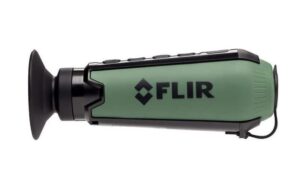
This FLIR Mini is a smaller version of the ocean scout miniaturized to fit into a cargo pants pocket. Despite its small size, and lightweight, it’s decent in performance and will give a defined image of a target up to a distance of 100 meters.
The thermal sensor has a resolution of 160 x 120 pixels, and the final image is displayed on a screen measuring 640 x 480 pixels.
It’s tough and can withstand some punishment outside, such as impact and harsh elements like rain and fog. This monocular is also simple to use due to its simplified controls, which include only four buttons for all functions and an intuitive interface.
Overall, the Scout mini will serve you well if you need a monocular to use over shorter distances. It however isn’t a preferred option if you intend to capture far-off targets.
Features
- Sensor resolution: 160 × 120
- 640 × 480 LCD Display
- FLIR Proprietary Digital Detail Enhancement™
- Image capture and video recording capability
- IP-67, waterproof rating
- Internal Li-Ion battery
- Battery life: 5 hours
- Dimensions: 6.0″ × 2″ × 2″
- Weights 170 grams.
Best Thermal Monocular Buying Guide
These are the characteristics that one should consider when buying a thermal monocular for under $1000
Sensor resolution
A thermal sensor is used to detect the thermal energy and convert it into an electrical signal that is used to display a thermogram image to the user. These sensors are available in different resolutions, examples include
- 160 x 120 pixels
- 384 x 288 pixels
- 640 x 480 pixels
The microbolometer’s sensitivity, detection range, and ability to produce sharper images increase with the number of pixels. Although these cost-effective choices lack a powerful high-end sensor, they do include mid-range sensors that work well over closer ranges.
Display resolution
It can be confusing comparing this to the sensor’s resolution, it’s important however that you consider looking at it, because it denotes the total vertical and horizontal pixels on the screen that displays the thermogram.
Like the sensor resolution, however, the higher the resolution the better the image will appear to the user. Examples of screen resolutions are 4k FHD and HD.
- 4K-3840 x 2160 pixel
- FHD-1920 x 1080 pixels
- HD-1080 x 720 pixels
Magnification
The level of magnification, which is denoted by ‘X,’ shows how much the target image is enlarged relative to the original one displayed without magnification. 3x magnification, for instance, means that the image is 3 times the original.
Magnification is important for spotting distant targets since their faint heat signatures often go undetected at such a distance. Because of this, monoculars frequently come with magnifications for example 2.5x and 4x, with the more powerful ones having a higher magnification.
Refresh rate
This is shown in Hz and refers to the many times that an image is regenerated on the screen per second. A higher refresh rate results in a sharper image, and less lag, especially when one is tracking a moving target and moving the monocular in the process.
Battery life
The thermal sensor and the display are both powered by a battery, therefore the more potent it is the longer the thermal monocular, will work. A good thermal monocular should give you a decent life, of more than a few hours to make sure that you have the best of your time outdoors.
Durability
Even for the ones that cost under $1000, a thermal monocular is an expensive piece of equipment, that may be a real nuisance to repair or replace.
Although damage is occasionally unavoidable, a decent monocular should have some robust qualities like sturdy housing and waterproofing, ensuring that it can handle some of the severity that comes with the outdoors.
Weight
Until you have to move for hours on end with a heavy monocular, this may not seem like a quality of actual relevance.
Although the ideal weight varies depending on the user, it’s good for a monocular to be light enough to be comfortable to use especially for extended periods of time without feeling exhausted.
Color palettes
These are the contrasting colors on the thermogram, that represent objects of different temperatures or thermal energy. If you have a certain preference for the colors that are used on a monogram, it’s a good thing that some thermal monoculars give you the option of different color palettes.
Thermal Monocular FAQs
How do you use a thermal monocular?
A thermal monocular has various uses which include;
- Security Surveillance-When its extremely dark, the thermal monocular can be used to carry out a surveillance, they provide a covert way to monitor your premise without being noticed.
- Hunting-A thermal monocular is a common device used to identify animals that are hidden in thickets. A thermal monocular is also useful to identify wounded targets because the blood released gives off a heat signature.
- Search and rescue-In case of a disaster a monocular is a helpful device to identify victims through the obstacles.
Can a thermal monocular be used in daylight?
Yes! Many people prefer thermal imaging because it provides the user with the flexibility to use it both during the day and at night. Thermal imaging generates a thermogram image by measuring the temperature difference between a target object and its surroundings. Every object, including ice, emits thermal energy, and the temperature difference between two objects can be as small as 0.001 degree Celsius.
Conversely, night vision makes use of an intensifier tube to boost the ambient light surrounding a target. This means that the bright light present in daylight would be amplified, potentially damaging the intensifier tube or the user’s eye.
See also: Can you use a thermal scope during the day
Which is the best thermal monocular for hunting?
Choosing the best thermal monocular for hunting is primarily a matter of personal preference. However, one highly rated choice is the AGM Fuzion LRF, which has a higher price tag. For around $1000, one can’t go wrong with an ATN OTS-XLT 2.5-10x.
CONCLUSION
After reading through this article, you’ll have familiarized yourself with the best thermal monocular under $1000. These monocular are not only cheap but will be of good value to anyone who doesn’t need to maximize the capabilities of the high-end monocular priced in the $3000 range. It’s noteworthy the buying guide provided covers monoculars at all prices and will still be useful if you need to get a pricier alternative.
Related
